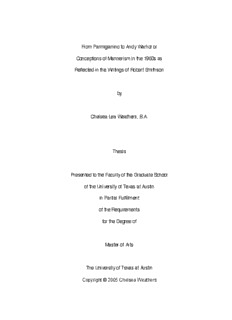
From Parmigianino to Andy Warhol or Conceptions of Mannerism in PDF
Preview From Parmigianino to Andy Warhol or Conceptions of Mannerism in
From Parmigianino to Andy Warhol or Conceptions of Mannerism in the 1960s as Reflected in the Writings of Robert Smithson by Chelsea Lea Weathers, B.A. Thesis Presented to the Faculty of the Graduate School of the University of Texas at Austin in Partial Fulfillment of the Requirements for the Degree of Master of Arts The University of Texas at Austin Copyright © 2005 Chelsea Weathers Acknowledgments I am very grateful to my advisor, Ann Reynolds, for her unflagging support throughout the research and writing of this thesis. Thank you also to Linda Henderson, whose insightful comments and suggestions have been a great help. And to Amanda Douberley, thank you for reading draft after draft, for offering some of the most useful advice I could hope for during this process, and of course for being a great friend by helping me to maintain a real sense of humor over the past few years. I also thank my father, who has been extremely patient with me, especially in my final days of formatting. My mother has been equally understanding; I could not have done this without her. Finally, I want to thank Melissa Moody. For encouraging me and challenging me nearly every step of the way, this thesis is somehow partly yours. From Parmigianino to Andy Warhol or Conceptions of Mannerism in the 1960s as Reflected in the Writings of Robert Smithson by Chelsea Lea Weathers, M.A. The University of Texas at Austin, 2005 SUPERVISOR: Ann Reynolds This thesis is an analysis of Robert Smithson’s use of the term “Mannerism” in his essays and criticism from the 1960s. During that decade, the scholarship on Mannerist art constitutes a reinvention of the meaning of Mannerism, as an aesthetic attitude with positive attributes rather than a period of decline following the Renaissance. Adopting both the conclusions and tactics of scholars’ conceptions of Mannerism, Smithson utilizes Mannerism in his writing to discuss trends in contemporary art and criticism. Mannerism becomes Smithson’s critical tool to oppose the ideal of artistic and material purity advocated by formalist critics, particularly Clement Greenberg and Michael Fried. Eventually Smithson formulates what he calls a “Mannerist esthetic,” an artistic sensibility that embraces those elements considered “corrupt” by formalist critics. Table of Contents Chapter 1. Introduction: Neo-Mannerism and the Myth of the Renaissance................................................1 Chapter 2. Shape as Farce: The Framing Edge and the Formalist Culture-Hero..................................................18 Chapter 3. Artifice and Objecthood, or Surfaces and the Mannerist Mask............................................................42 Chapter 4. Conclusion: Restoring the Rules of the Game............................................................................64 Illustrations....................................................................................................73 Bibliography...................................................................................................85 Vita................................................................................................................93 List of Illustrations 1. Robert Morris, Untitled, 1963. Lead, 10” x 8”. Image from Robert Smithson, “Entropy and the New Monuments,” Artforum 4, no. 10 (June 1966), 28. 2. Rosso Fiorentino, Moses Defending the Daughters of Jethro, c. 1523– 24. Oil on canvas, 63” x 46.1”. Galleria degli Uffizi, Florence. Image from Jacques Bousquet, Mannerism: The Painting and Style of the Late Renaissance, translated by Simon Watson Taylor (New York: George Braziller, Inc., 1964). 3. Barnett Newman, Untitled 4, 1950. Oil on canvas, 74” x 6”. Collection of Mr. and Mrs. I.M. Pei. Image from Richard Shiff, Carol C. Mancusi- Ungaro, and Heide Colsman Freyberger, Barnett Newman: A Catalogue Raisonne (New York and New Haven: Yale University Press, 2004). 4. Kenneth Noland, Hover, 1963. Acrylic on canvas, 69” x 69”. Fogg Art Museum, Harvard University. Image from Diane Waldman, Kenneth Noland: A Retrospective (New York: Harry N. Abrams, 1977). 5. Kenneth Noland, Magic Box, 1959. Acrylic on canvas, 93” x 93”. The Metropolitan Museum of Art, New York. Image from Diane Waldman, Kenneth Noland: A Retrospective (New York: Harry N. Abrams, 1977). 6. Frank Stella, Tampa, 1963. Red lead on canvas, 8.28’ x 8.28’. Private Collection. Image from Lawrence Rubin, Frank Stella: Paintings, 1958 to 1965, A Catalogue Raisonne (New York: Stewart, (New York: The Viking Press, 1982),Tabori & Cheng, 1986). 7. Rembrandt van Rijn, Self-Portrait, 1629–31. Oil on panel, 16.2” x 13.3”. Rijksmuseum, Amsterdam. Image from Christophper Wright, Rembrandt: Self-Portraits (New York: The Viking Press, 1982). 8. Parmigianino, Madonna of the Long Neck, c. 1534–1539. Oil on panel, 85” x 52”. Galleria degli Uffizi, Florence. Image from David Franklin, The Art of Parmigianino (New Haven and London: Yale University Press, 2003). 9. Pieter Brueghel the Elder, The Tower of Babel, 1563. Oil on panel, 44” x 45”. Kunsthistorisches Museum, Vienna. Image from Timothy Foote, The World of Brueghel (New York: Time-Life Books, 1968). 10. Jacopo da Pontormo, Deposition, c. 1525–28. Oil on panel, 123.2” x 75.6”. Capponi Chapel, Santa Felicita, Florence. Image from Elisabetta Marchetti Letta, Pontormo, Rosso Fiorentino (Florence, SCALA, 1994). 11. Jules Olitski, Bunga 45, 1967. Painted aluminum, 10’ h. Image from Michael Fried, “Art and Objecthood,” Artforum 5, no. 10 (June 1967), 16. 12. Robert Smithson, Untitled, 1964–1965. Metal and plastic, 81” x 35” x 10”. Collection of Melvyn and Suellen Estrin. From Eugenie Tsai, et al, Robert Smithson (Los Angeles: Museum of Contemporary Art, in association with University of California Press, 2004).
Description: